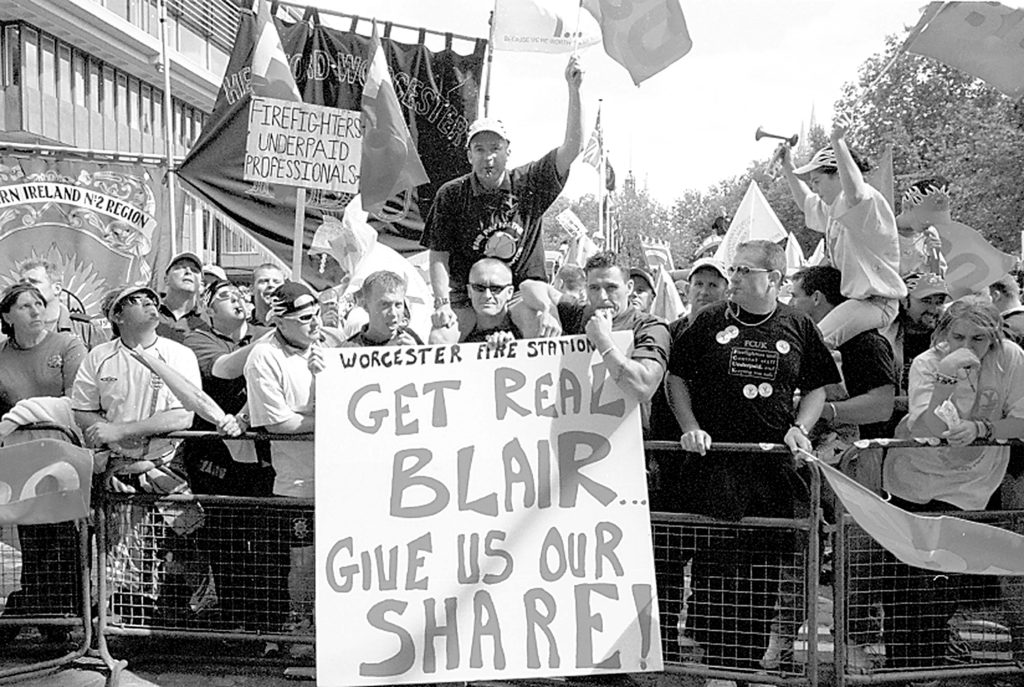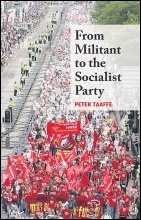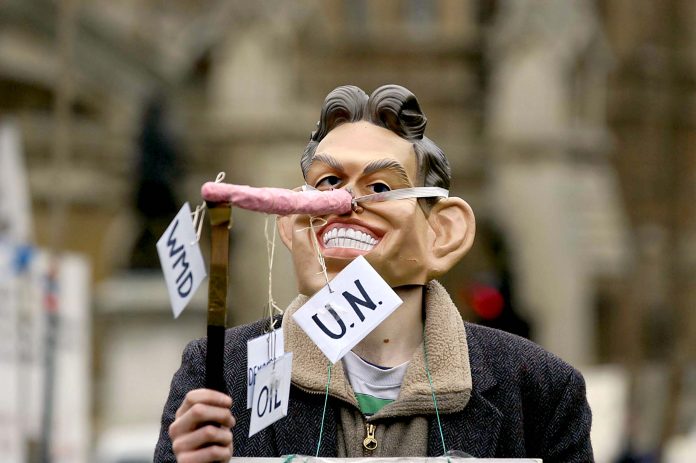Nick Chaffey, Socialist Party national committee
Twenty-five years ago, after 18 painful years of Thatcherism, Tony Blair was elected with a 178 seat majority. By the time of his resignation in 2007, he had become the longest-serving Labour prime minister. Yet Labour went on to defeat in the 2010 general election, losing close to five million votes from its peak in 1997. As Blair’s record is revived as a model for Keir Starmer’s Labour, what is the relevance of Blairism for today, and what is his legacy?
Promising much, Blair’s rebranded ‘New Labour’ must be judged by what it delivered and for whom. Jettisoning the social democratic goal of progressive reforms in favour of the working class, Blair adopted an openly capitalist agenda, carrying out a Thatcherite programme of privatisation and public sector cuts, alongside tax cuts for big business.
Abroad, Blair carried out the interests of British capitalism, entering six wars including the catastrophic invasion of Iraq. By the time of his resignation, Blair had accumulated a personal fortune and presided over a massive increase in the wealth of the super-rich while widening inequality. Blairism laid the basis for the Tories’ continued dismantling of the welfare state under the years of austerity and Covid pandemic.
Elected leader in 1995, Blair moved the party decisively to the right. Even prior to the triumph of Blairism, Labour governments had ultimately acted in defence of the capitalist system. Nonetheless, Labour leaders were susceptible to pressure from the working-class base of the party via its democratic structures, and were therefore unreliable from the point of view of the capitalist elite. New Labour was different.
How did Labour, a party formed by the trade unions, with its socialist Clause Four calling for the “common ownership of the means of production, distribution and exchange”, end up as a tool for the interests of capitalism and big business?
New Labour prepared in opposition
Blair exploited the desperation to remove the Tories, arguing that rejecting radical socialist policies would win the centre ground and a majority in Westminster. In preparing for power, Blair scrapped Clause Four, adopted in 1918 against the background of the Russian Revolution. Attempts to do so by previous right-wing leaders had failed.
Blair was able to succeed in the aftermath of the collapse of the Stalinist regimes that had existed in Russia and Eastern Europe. While bearing no resemblance to genuine socialism, these brutal dictatorships were nonetheless based on very distorted forms of planned economies. Their collapse led to a wave of capitalist triumphalism, and the widespread acceptance that the ‘market’ was the way forward.
Moving Labour decisively into a pro-capitalist position was accompanied by rule changes that weakened the democratic role of the trade unions, members and conference decision making. Leaning on conservative right-wing trade union leaders and drawing on the defeat of the miners, rather than their fighting determination and the important Militant-led victories of Liverpool council and against the poll tax, Clause Four was re-written. The proposals to remove calls for public ownership passed with the backing of 90% of constituency branches.
For Peter Mandelson this was New Labour, “intensely relaxed about people getting filthy rich”, ideologically recast and organisationally neutered. Blair’s New Labour adopted Thatcherism just as the voters were preparing to reject the toxic Tory era in the general election.
As Peter Taaffe explains in his book covering the period, ‘From Militant to the Socialist Party’: “Now that the Blair counter-revolution had destroyed the workers’ political voice [our dual tasks were] to fight for new, broad socialist parties of the working class, while maintaining the thread of a revolutionary, Marxist perspective and organisation.”

Blair in power for the 1%
After the vicious neo-liberal policies of Thatcherism, with sustained attacks on the working class and trade unions, the election of a Labour government came with a sense of relief as much as hope. Blair’s acolytes claim his rebranding of New Labour clinched the election, but in reality a mood of ‘anything but the Tories’ got Blair into Number 10.
The first signs were ominous. Thatcher was the first to visit Blair in Number 10. As if to reinforce from day one what was to be expected under chancellor Gordon Brown, Labour retained Tory spending limits, developed and implemented Tory plans to end free education – introducing £1,000 a-year tuition fees in 1998 – and retained all the Tory anti-trade union legislation in readiness for inevitable opposition from the trade unions.
Some shine was given to Blair by the impression of economic competence as recessions were avoided. Chancellor Brown even claimed to have ended the cycle of boom and bust; his delusions were shattered in the financial crisis of 2007-08.
Blair and Brown had been the fortunate beneficiaries of Britain’s sudden ejection from the European Exchange Rate Mechanism on Black Wednesday in 1992 and the devaluation of sterling, which gave a limited boost to exports. However, this was mainly a joyless boom for the working class. It saw continued deindustrialisation. Car manufacturers closed with devastating impacts on jobs in Dagenham, east London and in the West Midlands, with the right-wing trade union leadership unwilling to lead resistance.
In the public sector, the huge expansion of disastrous Tory policies, like Private Finance Initiatives in the NHS and academisation in education, extended privatisation far further than even Thatcher had dared to go. The continued break-up of the NHS contributed to increasing unpopularity as the expectations of New Labour improving workers’ lives waned. Here too, the right-wing-led public sector unions failed to fight. On the railways, underinvestment and privatisation saw horrific rail crashes, and calls made for renationalisation from the transport union RMT gained overwhelming support.
By the 2001 general election, the signs were clear, as working-class voters fell away. But with the Tory electoral recovery failing to materialise, Blair won a second term. In 2001, economic storm warnings as the dot-com bubble burst challenged Labour’s fortunes. Industrial conflicts developed as New Labour sought to hold down public sector pay, with important political ramifications. Labour wheeled out the army to act as strike breakers when firefighters took strike action over pay. This led to the Fire Brigades Union’s disaffiliation from Labour in 2004. The RMT moved to back socialist candidates in Scotland in 2004, leading to its expulsion from Labour. And when prison officers in the POA union took strike action on pay, retribution followed with Labour outlawing strikes in the prison service.
In local government, Labour councils were failing to reverse the impact of Thatcher’s savage cuts, or tackle the housing crisis by building low-rent council housing. In Coventry, that led to the election of Socialist Party members Dave Nellist, Rob Windsor and Karen McKay to the council, leading the fight for council workers and working-class communities. Those who refused to vote through cuts were expelled, like Councillor Ian Page in Lewisham who went on, with Chris Flood, to lead Socialist Party campaigns opposing cuts and housing privatisation.
Imperialist war for oil in Iraq
Following the interests of big business at home, abroad Blair led British forces into six wars, more than any other Prime Minister. Following the Al-Qaida 9/11 terrorist attacks on the Twin Towers, Blair backed Bush’s initial attack on Afghanistan, and a seemingly rapid victory over the Taliban. But this was only a precursor to the planned disastrous invasion of Iraq.
Defeated in Vietnam in 1973, US public opposition to foreign wars had held US imperialism in check. But Bush seized the moment to try and rebuild US global military dominance, and with it economic and political control over Iraq’s oil supplies. Blair was accurately portrayed as Bush’s poodle, prepared to lend credibility to this adventure, aiming to boost Britain’s wealth and prestige. As we predicted it had the opposite effect, speeding up the decline of both US imperialism and Britain, its very junior partner in the war.
Universal opposition to the horror of Al-Qaida did not result in blanket support in the US, Britain, or internationally for the Bush-Blair war plans. The Socialist Party took a clear and consistent position – opposing both the imperialist war aims of the US and Britain, as well as the terrorist attacks of Al-Qaida. In opposition to the warmongering of Blair, we fought for workers’ unity and socialism. To end the brutal dictatorships in Iraq and elsewhere, it was the only the Iraqi working class and international workers’ solidarity that could offer a way out for the masses on a socialist basis.
We warned, correctly, that the invasion of Iraq would become a quagmire for imperialism and increase support for, and the threat from, Islamic fundamentalist terror groups in the Middle East and beyond.
As Bush and Blair pressed on with their war preparations, opposition grew, and demands for evidence and justification for the invasion hardened. This reached its peak in the mass anti-war protests of 15 February 2003. Millions took part globally, the White House was encircled, and over one million marched in London. Blair produced his ‘dodgy dossier’, alleging Iraq held weapons of mass destruction, later proved to be false, and pressed ahead with the invasion with all its devastating consequences. For this he is now seen justifiably as a war criminal in the eyes of many.
As the 2005 election loomed, discredited over the Iraq war, Blair won with a reduced majority. Calls for his removal increased, leading to his resignation in 2007. False expectations that Brown would be any different were firmly wiped out by the financial crash of 2007-08 and the multi-billion-pound bail-out of the banks to save capitalism. The working class suffered the consequences.
Potential for new workers’ parties
Drawing the necessary conclusions, that New Labour would represent capitalist interests, the Socialist Party was launched in 1996 in preparation for the election of 1997. In the election we stood a modest 18 candidates, a marker for future events that would sharply change consciousness and erode support for New Labour and Blair.
In the course of the anti-war movement the Socialist Party posed the idea of launching a new party that would link the opposition to war with the battles at home to oppose privatisation, low pay and inequality. It was not the first or last time that a critical opportunity was lost.
Had a new party been launched from the million-strong demo, and gained just a tenth of the marchers, it would have been the basis to fight the general election campaign of 2005 with mass forces. Such a stand could have tapped into disillusionment with New Labour and provided a political reference point for the working class as the financial crisis of 2007-08 unfolded.
Industrial battles which led to an important militancy amongst a fresh layer of trade union activists saw unions such as the RMT, PCS and FBU move left and elect more fighting leaders. The potential existed to consolidate the mood of opposition to New Labour’s pro-capitalist policies, and develop it into an organised form by taking serious steps towards launching a new workers’ party.
The alienation towards New Labour and the vacuum it presented dangerously allowed the far-right to make gains, with the re-emergence of the British National Party (BNP), which won 32 council seats in 2006. Alongside the anti-war movement, opposition to the BNP and racism could have fed youthful forces into a new party.
It was around the late RMT leader Bob Crow that a significant step forward was taken. In the 2009 European elections, the first post-war trade union-led alternative to Labour stood under the ‘No2EU – Yes to Democracy’ banner, opposing the pro-business European Union and its anti-worker legislation. This led to the formation of the Trade Unionist and Socialist Coalition (TUSC) in 2010, as a federal coalition, with the involvement of Bob Crow, the Socialist Party and others, that stood in the 2010 general election. In 2012, the RMT officially affiliated. By the 2015 general election TUSC stood 135 candidates alongside 650 council candidates.
Workers’ disenfranchised
Promising much, Blair delivered only for the super-rich, including Mandelson’s friends like the now infamous Russian oligarch Deripaksa. Inequality widened as New Labour allowed the rich to profit while pay, benefits and pensions for the working class were attacked.
Working-class voters deserted, opening the door to a return of the Tories in 2010 and a brutal decade of austerity.
Jeremy Corbyn’s election as Labour leader offered an opportunity to re-found Labour as a working-class party based on the trade unions with a socialist programme. Doing so would have required a determined campaign against the Blairites who continued to dominate the Parliamentary Labour Party and the party apparatus.
That opportunity has now been lost, with Blair’s replicant Keir Starmer firmly in charge. Siding with Johnson in ‘national unity’ through the Covid pandemic, and now over the war in Ukraine, Starmer is once more positioning Labour as a party capitalism can rely on in power. Despite this, as Johnson and the Tories’ divisions resurface and widen, a Starmer-led Labour government could be the outcome at the next election. However, based on pro-capitalist policies, it will be unable to provide a way forward for the working class.
In the face of a sharply deepening economic crisis, as workers are forced to organise, strike and fightback against the eroding effect of inflation on living standards, it remains an urgent task to build support in the trade unions for the idea of a new mass workers’ party. Such a party could lead an independent mass movement of the working class which, armed with socialist policies, could bring about a permanent end to the era of capitalist crisis, war, and inequality which Blair did so much to foster.
From Militant to the Socialist Party by Peter Taaffe

- Order now, £12+pp








